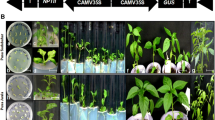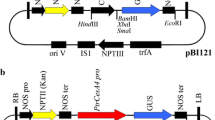Abstract
Transgenic technology has been successfully used for gene function analyses and trait improvement in cereal plants. However, its usage is limited in woody plants, especially in the difficult-to-transform but commercially viable hybrid poplar. In this work, an efficient regeneration and transformation system was established for the production of two hybrid aspen clones: Populus alba × P. berolinensis and Populus davidiana × P. bolleana. A plant transformation vector designed to express the reporter gene uidA, encoding β-glucuronidase (GUS), driven by the cauliflower mosaic virus 35S promoter, was used to detect transformation event at early stages of plant regeneration, and to optimize the parameters that may affect poplar transformation efficiency. Bacterium strain and age of leaf explant are two major factors that affect transformation efficiency. Addition of thidiazuron (TDZ) improved both regeneration and transformation efficiency. The transformation efficiency is approximately 9.3% for P. alba × P. berolinensis and 16.4% for P. davidiana × P. bolleana. Using this system, transgenic plants were usually produced in less than 1 month after co-cultivation. The growth characteristics and morphology of transgenic plants were identical to the untransformed wild type plants, and the transgenes could be inherited by vegetative propagation, as confirmed by PCR, Southern blotting, RT–PCR and β-glucuronidase staining analyses. The establishment of this system will help to facilitate the studies of gene functions in tree growth and development at a genome level, and as well as the introduction of some valuable traits in aspen breeding.







Similar content being viewed by others
Abbreviations
- AS:
-
Acetosyringone
- 6-BA:
-
6-Benzyladenine
- GUS:
-
β-Glucuronidase
- MS:
-
Murashige and Skoog (1962)
- NAA:
-
Naphthalene-acetic acid
- nptII:
-
Neomycin phosphotransferase gene
- TDZ:
-
Thidiazuron
References
Balatinecz JJ, Kretschmann DE, Leclercq A (2001) Achievements in the utilization of poplar wood-guideposts for the future. For Chron 77:265–269
Birch RG (1997) Plant transformation: problems and strategies for practical application. Annu Rev Plant Physiol Plant Mol Biol 48:297–326
Confalonieri M, Belenghi B, Balestrazzi A, Negri S, Facciotto G, Schenone G, Delledonne M (2000) Transformation of elite white poplar (Populus alba L.) cv. ‘Villafranca’ and evaluation of herbicide resistance. Plant Cell Rep 19:978–982
Confalonieri M, Balestrazzi A, Bisoffi S, Carbonera D (2003) In vitro culture and genetic engineering of Populus spp.: synergy for forest tree improvement. Plant Cell Tissue Org 72:109–138
Dai WH, Cheng ZM, Sargent W (2003) Plant regeneration and Agrobacterium-mediated transformation of two elite aspen hybrid clones from in vitro leaf tissues. In Vitro Cell Dev Biol Plant 39:6–11
De Block M (1990) Factors influencing the tissue culture and the Agrobacterium tumefaciens-mediated transformation of hybrid aspen and poplar clones. Plant Physiol 93:1110–1116
Delledonne M, Allegro G, Belenghi B, Balestrazzi A, Picco F, Levine A, Zelasco S, Calligari P, Confalonieri M (2001) Transformation of white poplar (Populus alba L.) with a novel Arabidopsis thaliana cysteine proteinase inhibitor and analysis of insect pest resistance. Mol Breed 7:35–42
Eriksson ME, Israelsson M, Olsson O, Moritz T (2000) Increased gibberellin biosynthesis in transgenic trees promotes growth, biomass production and xylem fiber length. Nat Biotechnol 18:784–788
Fillatti JJ, Sellmer J, McCown B, Haissig B, Comai L (1987) Agrobacterium-mediated transformation and regeneration of Populus. Mol Gen Genet 206:192–199
Fladung M, Kumar S, Ahuja MR (1997) Genetic transformation of Populus genotypes with different chimaeric gene constructs: transformation efficiency and molecular analysis. Transgene Res 6:111–121
Gallagher SR (1992) GUS protocols: using the GUS gene as a reporter of gene expression. Academic Press, San Diego
Gallardo F, Fu JM, Francisco RC, Garcia-Gutierrez A, Francisco MC, Kirby EG (1999) Expression of a conifer glutamine synthetase gene in transgenic poplar. Planta 210:19–26
Han KH, Gordon MP, Strauss SH (1996) Cellular and molecular biology of Agrobacterium-mediated transformation of plants and its application to genetic transformation of Populus. In: Bradshaw HD Jr, Stettler RF, Heilman PE, Hinckley TM (eds) Biology of Populus and its implication for management and conservation. National Research Council, Ottawa, pp 201–222
Han KH, Ma CP, Strauss SH (1997) Matrix attachment regions (MARs) enhance transformation frequency and transgene expression in poplar. Transgenic Res 6:415–420
Han KH, Meilan R, Ma CP, Strauss SH (2000) An Agrobacterium tumefaciens transformation protocol effective on a variety of cottonwood hybrids (genus Populus). Plant Cell Rep 19:315–320
Ho KC, Chang SH, Tsay JY, Tsai CJ, Chiang VL, Chen ZZ (1998) Agrobacterium tumefaciens mediated transformation of Eucalyptus camaldulensis and production of transgenic plants. Plant Cell Rep 17:675–680
Holsters M, De Waele D, Depicker A, Messens E, Van Montagu M, Schell J (1978) Transfection and transformation of Agrobacterium tumefaciens. Mol Gen Genet 163:181–187
Howe GT, Goldfarb B, Strauss SH (1994) Agrobacterium-mediated transformation of hybrid poplar suspension cultures and regeneration of transformed plants. Plant Cell Tissue Org 36:59–71
Hu WJ, Harding SA, Lung J, Popko JL, Ralph J, Stokke DD, Tsai CJ, Chiang VL (1999) Repression of lignin biosynthesis promotes cellulose accumulation and growth in transgenic trees. Nat Biotechnol 17:808–812
Huang YH, Mei M, Zeng JW, Zhou BR, Xia R, Yi GJ (2009) Study on expression character of gas gene contained in two different plasmids on plant cell and Agrobacterium tumefaciens. Genomics Appl Biol 28:34–38
Jouanin L, Brasileiro ACM, Leple JC, Pilate G, Cornu D (1993) Genetic transformation: a short review of methods and their applications, results and perspectives for forest trees. Ann Sci For 50:325–336
Kang BG, Ye X, Osburn LD, Stewart CN Jr, Cheng ZM (2010) Transgenic hybrid aspen overexpressing the Atwbc19 gene encoding an ATP-binding cassette transporter confers resistance to four aminoglycoside antibiotics. Plant Cell Rep 29:643–650
Kim MS, Klopfenstein NB, Chun YW (1997) Agrobacterium-mediated transformation of Populus species. In: Klopfenstein NB, Chun YW, Kim MS, Ahuja MR (eds) Micropropagation, genetic engineering, and molecular biology of Populus. Gen Tech Rep RM-GTR-297, US Dep Agric-For Serv, Fort Collins, Colo, pp 51–59
Leple JC, Brasileiro ACM, Michel MF, Delmotte F, Jouanin L (1992) Transgenic poplars: expression of chimeric genes using four different constructs. Plant Cell Rep 11:137–141
Pilate G, Guiney E, Holt K, Petit-Conil M, Lapierre C et al (2002) Field and pulping performances of transgenic trees with altered lignification. Nat Biotechnol 20:607–612
Rishi AS, Nelson ND, Goyal A (2001) Genetic modification for improvement of Populus. Physiol Mol Biol Plants 7:7–21
Sepanen SK, Syrjala L, Weissenberg KV, Teeri TH, Paajanen L, Pappinen A (2004) Antifungal activity of stilbenes in in vitro bioassays and in transgenic Populus expressing a gene encoding pinosylvin synthase. Plant Cell Rep 22:584–593
Song JY, Lu SF, Chen ZZ, Lourenco R, Chiang VL (2006) Genetic transformation of populus trichocarpa genotype Nisqually-1: a functional genomic tool for woody plants. Plant Cell Physiol 47:1582–1589
Stettler RF, Bradshaw HD Jr, Heilman PE, Hinckley TM (eds) (1996) Biology of Populus and its implication for management and conservation. National Research Council Canada, Ottawa
Tsai CJ, Podila GK, Chiang VL (1994) Agrobacterium-mediated transformation of quaking aspen (Populus tremuloides) and regeneration of transgenic plants. Plant Cell Rep 14:94–97
Tzfira T, Ben-Meir H, Vainstein A, Altman A (1996) Highly efficient transformation and regeneration of aspen plants through shoot-bud formation in root culture. Plant Cell Rep 15:566–571
Tzfira T, Jensen CS, Wang W, Zuker A, Vincour B, Altman A et al (1997) Transgenic Populus tremula: a step-bystep protocol for its Agrobacterium-mediated transformation. Plant Mol Biol Rep 15:219–235
Wei H, Meilan R, Brunner AM, Skinner JS, Ma CP, Strauss SH (2006) Transgenic sterility in Populus: expression properties of the poplar PTLF, Agrobacterium NOS and two minimal 35S promoters in vegetative tissues. Tree Physiol 26:401–410
Yang L, Sun Y, Xie L, Liang A (2010) A novel approach for in situ bud transformation of Populus by Agrobacterium. Scand J For Res 25:3–9
Yevtushenko DP, Misra S (2010) Efficient Agrobacterium-mediated transformation of commercial hybrid poplar Populus nigra L. × P. maximowiczii A. Henry. Plant Cell Rep 29:211–221
Acknowledgments
We thank Prof. Gui-Feng Liu (Northeast Forestry University, China) for providing the Shanxin yang (P. davidiana × P. bolleana) clone. This work was supported by the following grants: the National Natural Science Foundation of China (30872044; 30800880; 3100012; 31000288), the National Basic Research Program of China (2010CB126600), the National mega project of GMO crops (2008ZX08001-003; 2008ZX08004-002; 2008ZX08010-004); Shanghai Science & Technology Committee: 10DZ2271800); and Shanghai Key Laboratory of Bio-Energy Crops.
Author information
Authors and Affiliations
Corresponding author
Additional information
Communicated by L. Jouanin.
Rights and permissions
About this article
Cite this article
Wang, H., Wang, C., Liu, H. et al. An efficient Agrobacterium-mediated transformation and regeneration system for leaf explants of two elite aspen hybrid clones Populus alba × P. berolinensis and Populus davidiana × P. bolleana . Plant Cell Rep 30, 2037–2044 (2011). https://doi.org/10.1007/s00299-011-1111-1
Received:
Revised:
Accepted:
Published:
Issue Date:
DOI: https://doi.org/10.1007/s00299-011-1111-1




